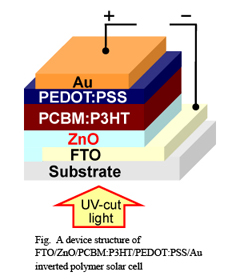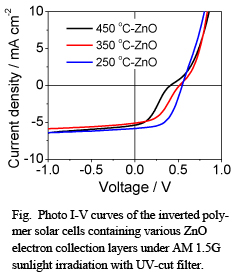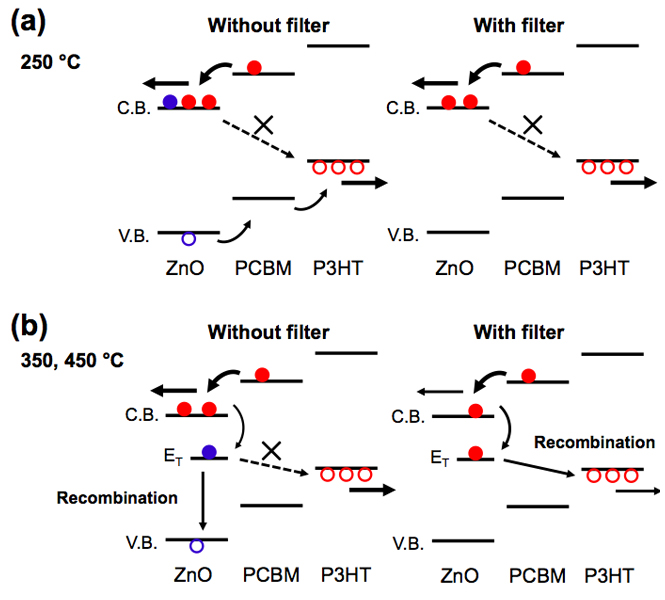- Home
- Highlights
- Organic solar cell fabrication: Keeping it cool for best results
Highlights
Organic solar cell fabrication: Keeping it cool for best results
Organic solar cells are low-cost and flexible, so there is great interest in optimising their power conversion efficiency further by improving the material properties of the electrodes and the active layer, such as crystallinity and morphology. However Takayuki Kuwabara and colleagues at Kanazawa University and the Japan Science and Technology Agency have now demonstrated that in simulated sunlight with UV omitted, photoconductivity is actually decreased when zinc oxide (ZnO) crystalline quality is improved.

Kuwabara and his colleagues investigated a type of ‘inverted’ solar cell. In these structures the transparent conducting oxide such as an indium tin oxide electrode (ITO) or a fluorine-doped indium tin oxide electrode (FTO) is coated in a stable n-type metal oxide to improve the device durability against oxidation by the atmosphere. The researchers fabricated solar cells with a thin film of ZnO prepared on FTO electrodes.
They monitored the effect of ZnO preparation temperature on the device performance under simulated sunlight irradiation with and without UV. The devices consistently performed with power conversion efficiencies of around 3% with UV. However when the UV light was cut, those with ZnO heated to higher temperatures — 350 °C and 450 °C — showed lower performance than the device with ZnO heated to only 250 °C.

Higashida and his team conducted a series of experiments with females and males living in established family groups. Pups were removed from the cage for a short time, while one or both parents remained in the nest. The pups were then returned to the cage, away from the nest. Lone females nearly always brought the pups back to the nest, but lone males were less likely to do so.
The researchers explain the decreased performance in terms of charge recombination. This suggests that recombination centers were formed at the ZnO/PCBM:P3HT interface by grain boundary of ZnO micro-crystallization or adsorbed oxygen anions. In the presence of UV, devices with high-temperature ZnO performed as well as their low-temperature counterparts because the recombination centers were occupied by electrons excited in the ZnO. In the absence of UV, electrons were not excited in ZnO and the carriers generated in the organic active layer recombined by using the trap site.
The authors add, “We conclude that this is a key condition for the fabrication of inverted cells which can generate electricity effectively without UV light.”
Publication and Affiliation
Takayuki Kuwabara*1,2, Chika Tamai1, Yoshihiro Omura1, Takahiro Yamaguchi1, Tetsuya Taima1,2,3, Kohshin Takahashi*1,2 Effect of UV light irradiation on photovoltaic characteristics of inverted polymer solar cells containing sol–gel zinc oxide electron collection layer. Organic Electronics 14, 649–656 (2013)
Link
1.Graduate School of Natural Science and Technology, Kanazawa University, Kakuma-machi, Kanazawa, Ishikawa 920-1192, Japan
2.Research Center for Sustainable Energy and Technology, Kanazawa University, Kakuma-machi, Kanazawa, Ishikawa 920-1192, Japan
3.JST-PRESTO, Japan Science and Technology Agency (JST), 4-1-8 Honcho Kawaguchi, Saitama 332-0012, Japan
*corresponding author, e-mail address: tkuwa@t.kanazawa-u.ac.jp
ID: 201302H017

